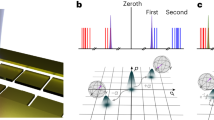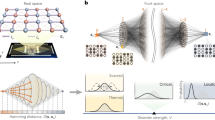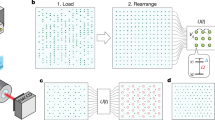Abstract
Magnetic molecules, modelled as finite-size spin systems, are test-beds for quantum phenomena1 and could constitute key elements in future spintronics devices2,3,4,5, long-lasting nanoscale memories6 or noise-resilient quantum computing platforms7,8,9,10. Inelastic neutron scattering is the technique of choice to probe them, characterizing molecular eigenstates on atomic scales11,12,13,14. However, although large magnetic molecules can be controllably synthesized15,16,17,18, simulating their dynamics and interpreting spectroscopic measurements is challenging because of the exponential scaling of the required resources on a classical computer. Here, we show that quantum computers19,20,21,22 have the potential to efficiently extract dynamical correlations and the associated magnetic neutron cross-section by simulating prototypical spin systems on a quantum hardware22. We identify the main gate errors and show the potential scalability of our approach. The synergy between developments in neutron scattering and quantum processors will help design spin clusters for future applications.
This is a preview of subscription content, access via your institution
Access options
Access Nature and 54 other Nature Portfolio journals
Get Nature+, our best-value online-access subscription
$29.99 / 30 days
cancel any time
Subscribe to this journal
Receive 12 print issues and online access
$209.00 per year
only $17.42 per issue
Buy this article
- Purchase on Springer Link
- Instant access to full article PDF
Prices may be subject to local taxes which are calculated during checkout




Similar content being viewed by others
Code availability
The custom Python scripts for the quantum har-dware and original codes are available from the corresponding author upon reasonable request.
Data availability
The data that support the plots and other findings of this study are available from the corresponding author upon reasonable request.
References
Gaudenzi, R., Burzurí, E., Maegawa, S., van der Zandt, S. J. & Luis, F. Quantum Landauer erasure with a molecular nanomagnet. Nat. Phys. 14, 565–568 (2018).
Vincent, R., Klyatskaya, S., Ruben, M., Wernsdorfer, W. & Balestro, F. Electronic read-out of a single nuclear spin using a molecular spin transistor. Nature 488, 357–360 (2012).
Ganzhorn, M., Klyatskaya, S., Ruben, M. & Wernsdorfer, W. Strong spin–phonon coupling between a single-molecule magnet and a carbon nanotube nanoelectromechanical system. Nat. Nanotechnol. 8, 165–169 (2013).
Misiorny, M., Hell, M. & Wegewijs, M. R. Spintronic magnetic anisotropy. Nat. Phys. 9, 801–805 (2013).
Cervetti, C. et al. The classical and quantum dynamics of molecular spins on graphene. Nat. Mater. 15, 164–168 (2016).
Goodwin, C. A. P., Ortu, F., Reta, D., Chilton, N. F. & Mills, D. P. Molecular magnetic hysteresis at 60 kelvin in dysprosocenium. Nature 548, 439–442 (2017).
Shiddiq, M. et al. Enhancing coherence in molecular spin qubits via atomic clock transitions. Nature 531, 348–351 (2016).
Ferrando-Soria, J. et al. A modular design of molecular qubits to implement universal quantum gates. Nat. Commun. 7, 11377 (2016).
Thiele, S. et al. Electrically driven nuclear spin resonance in single-molecule magnets. Science 344, 1135–1138 (2014).
Hussain, R. et al. Coherent manipulation of a molecular Ln-based nuclear qudit coupled to an electron qubit. J. Am. Chem. Soc. 140, 9814–9818 (2018).
Baker, M. L. et al. Spin dynamics of molecular nanomagnets unravelled at atomic scale by four-dimensional inelastic neutron scattering. Nat. Phys. 8, 906–911 (2012).
Chiesa, A. et al. Magnetic exchange interactions in the molecular nanomagnet Mn12. Phys. Rev. Lett. 119, 217202 (2017).
Garlatti, E. et al. Anisotropy of CoII transferred to the Cr7Co polymetallic cluster via strong exchange interactions. Chem. Sci. 9, 3555–3562 (2018).
Garlatti, E. et al. Portraying entanglement between molecular qubits with four-dimensional inelastic neutron scattering. Nat. Commun. 8, 14543 (2017).
Whitehead, G. F. S. et al. A ring of rings and other multicomponent assemblies of cages. Angew. Chem. Int. Ed. 52, 9932–9935 (2013).
Schröder, C. et al. Competing spin phases in geometrically frustrated magnetic molecules. Phys. Rev. Lett. 94, 017205 (2005).
Todea, A. M. et al. Extending the (Mo)Mo512M30 capsule keplerate sequence: a Cr30 cluster of S = 3/2 metal centers with a Na(H2O)12 encapsulate. Angew. Chem. Int. Ed. 46, 6106–6110 (2007).
Baniodeh, A. et al. High spin cycles: topping the spin record for a single molecule verging on quantum criticality. npj Quantum Mater. 3, 10 (2018).
Kelly, J. et al. State preservation by repetitive error detection in a superconducting quantum circuit. Nature 519, 66–69 (2015).
Corcoles, A. D. et al. Demonstration of a quantum error detection code using a square lattice of four superconducting qubits. Nat. Commun. 6, 6979 (2015).
Gambetta, J. M., Chow, J. M. & Steffen, M. Building logical qubits in a superconducting quantum computing system. npj Quantum Inf. 3, 2 (2017).
Kandala, A. et al. Hardware-efficient variational quantum eigensolver for small molecules and quantum magnets. Nature 549, 242–246 (2017).
Lovesey, S. W. Theory of Neutron Scattering from Condensed Matter (Oxford Univ. Press, Oxford, 2003).
Georgescu, I. M., Ashab, S. & Nori, F. Quantum simulation. Rev. Mod. Phys. 86, 153 (2014).
Blais, A., Huang, R.-S., Wallraff, A., Girvin, S. M. & Schoelkopf, R. J. Cavity quantum electrodynamics for superconducting electrical circuits: an architecture for quantum computation. Phys. Rev. A 69, 062320 (2004).
Gambetta, J. M. et al. Characterization of addressability by simultaneous randomized benchmarking. Phys. Rev. Lett. 109, 240504 (2012).
Somma, R., Ortiz, G., Gubernatis, J. E., Knill, E. & Laflamme, R. Simulating physical phenomena by quantum networks. Phys. Rev. A 65, 042323 (2002).
McKay, D. C., Wood, C. J., Sheldon, S., Chow, J. M. & Gambetta, J. M. Efficient Z gates for quantum computing. Phys. Rev. A 96, 022330 (2017).
Vidal, G. & Dawson, C. M. Universal quantum circuit for two-qubit transformations with three controlled-NOT gates. Phys. Rev. A 69, 010301(R) (2004).
Eaton, S. S., Eaton, G. R. & Chang, C. K. Synthesis and geometry determination of cofacial diporphyrins. EPR spectroscopy of dicopper diporphyrins in frozen solution. J. Am. Chem. Soc. 107, 3177–3184 (1985).
Wootters, W. K. Entanglement of formation of an arbitrary state of two qubits. Phys. Rev. Lett. 80, 2245–2248 (1998).
Sheldon, S., Magesan, E., Chow, J. M. & Gambetta, J. M. Procedure for systematically tuning up cross-talk in the cross-resonance gate. Phys. Rev. A 93, 060302(R) (2016).
Chiesa, A. et al. Digital quantum simulators in a scalable architecture of hybrid spin-photon qubits. Sci. Rep. 5, 16036 (2015).
Acknowledgements
This work was partly funded by the Italian Ministry of Education and Research (MIUR) through PRIN Project 2015 HYFSRT, ‘Quantum Coherence in Nanostructures of Molecular Spin Qubits’. The authors also acknowledge useful discussions with G. Amoretti and G. Prando.
Author information
Authors and Affiliations
Contributions
A.C., F.T. and M.G. used the IBM chips to implement gate sequences. Analysis of the experimental results was carried out by A.C., F.T., D.G., I.T. and S.C. Numerical calculations were performed by A.C. and F.T. P.S., I.T., D.G. and S.C. conceived the work and discussed the results with other co-authors. A.C. and S.C. wrote the manuscript with input from all co-authors.
Corresponding author
Ethics declarations
Competing interests
The authors declare no competing interests.
Additional information
Journal Peer Review Information: Nature Physics thanks Emilio Lorenzo, David Tennant and the other anonymous reviewer(s) for their contribution to the peer review of this work.
Publisher’s note: Springer Nature remains neutral with regard to jurisdictional claims in published maps and institutional affiliations.
Supplementary information
Supplementary Information
Supplementary Figures 1–27, Supplementary Tables 1–6 and Supplementary References 1–9.
Rights and permissions
About this article
Cite this article
Chiesa, A., Tacchino, F., Grossi, M. et al. Quantum hardware simulating four-dimensional inelastic neutron scattering. Nat. Phys. 15, 455–459 (2019). https://doi.org/10.1038/s41567-019-0437-4
Received:
Accepted:
Published:
Issue Date:
DOI: https://doi.org/10.1038/s41567-019-0437-4
This article is cited by
-
Quantum many-body simulations on digital quantum computers: State-of-the-art and future challenges
Nature Communications (2024)
-
Exploring finite temperature properties of materials with quantum computers
Scientific Reports (2023)
-
Stabilizing multiple topological fermions on a quantum computer
npj Quantum Information (2022)
-
Quantum algorithms for quantum dynamics
Nature Computational Science (2022)
-
Comparative Dynamical Study of a Bound Entangled State
International Journal of Theoretical Physics (2022)



